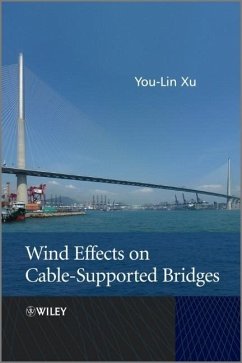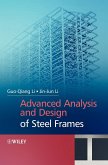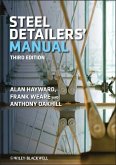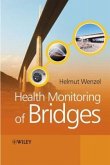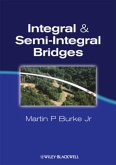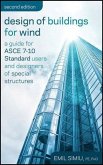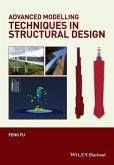You-Lin Xu
Wind Effects on Cable-Supported Bridges
You-Lin Xu
Wind Effects on Cable-Supported Bridges
- Gebundenes Buch
- Merkliste
- Auf die Merkliste
- Bewerten Bewerten
- Teilen
- Produkt teilen
- Produkterinnerung
- Produkterinnerung
As an in-depth guide to understanding wind effects on cable-supported bridges, this book uses analytical, numerical and experimental methods to give readers a fundamental and practical understanding of the subject matter. It is structured to systemically move from introductory areas through to advanced topics currently being developed from research work. The author concludes with the application of the theory covered to real-world examples, enabling readers to apply their knowledge.
The author provides background material, covering areas such as wind climate, cable-supported bridges,…mehr
Andere Kunden interessierten sich auch für
![Natural Ventilation of Buildings Natural Ventilation of Buildings]() David EtheridgeNatural Ventilation of Buildings141,99 €
David EtheridgeNatural Ventilation of Buildings141,99 €![Advanced Analysis and Design of Steel Frames Advanced Analysis and Design of Steel Frames]() Gouqiang LiAdvanced Analysis and Design of Steel Frames182,99 €
Gouqiang LiAdvanced Analysis and Design of Steel Frames182,99 €![Steel Detailer's Manual Steel Detailer's Manual]() Alan HaywardSteel Detailer's Manual144,99 €
Alan HaywardSteel Detailer's Manual144,99 €![Health Monitoring of Bridges Health Monitoring of Bridges]() Helmut WenzelHealth Monitoring of Bridges112,99 €
Helmut WenzelHealth Monitoring of Bridges112,99 €![Integral and Semi-Integral Bridges Integral and Semi-Integral Bridges]() Martin P Burke JrIntegral and Semi-Integral Bridges155,99 €
Martin P Burke JrIntegral and Semi-Integral Bridges155,99 €![Design of Buildings for Wind Design of Buildings for Wind]() Emil SimiuDesign of Buildings for Wind169,99 €
Emil SimiuDesign of Buildings for Wind169,99 €![Advanced Modelling Techniques in Structural Design Advanced Modelling Techniques in Structural Design]() Feng FuAdvanced Modelling Techniques in Structural Design144,99 €
Feng FuAdvanced Modelling Techniques in Structural Design144,99 €-
-
-
As an in-depth guide to understanding wind effects on cable-supported bridges, this book uses analytical, numerical and experimental methods to give readers a fundamental and practical understanding of the subject matter. It is structured to systemically move from introductory areas through to advanced topics currently being developed from research work. The author concludes with the application of the theory covered to real-world examples, enabling readers to apply their knowledge.
The author provides background material, covering areas such as wind climate, cable-supported bridges, wind-induced damage, and the history of bridge wind engineering. Wind characteristics in atmospheric boundary layer, mean wind load and aerostatic instability, wind-induced vibration and aerodynamic instability, and wind tunnel testing are then described as the fundamentals of the subject. State-of-the-art contributions include rain-wind-induced cable vibration, wind-vehicle-bridge interaction, wind-induced vibration control, wind and structural health monitoring, fatigue analysis, reliability analysis, typhoon wind simulation, non-stationary and nonlinear buffeting response. Lastly, the theory is applied to the actual long-span cable-supported bridges.
Structured in an easy-to-follow way, covering the topic from the fundamentals right through to the state-of-the-art
Describes advanced topics such as wind and structural health monitoring and non-stationary and nonlinear buffeting response
Gives a comprehensive description of various methods including CFD simulations of bridge and vehicle loading
Uses two projects with which the author has worked extensively, Stonecutters cable-stayed bridge and Tsing Ma suspension bridge, as worked examples, giving readers a practical understanding
The author provides background material, covering areas such as wind climate, cable-supported bridges, wind-induced damage, and the history of bridge wind engineering. Wind characteristics in atmospheric boundary layer, mean wind load and aerostatic instability, wind-induced vibration and aerodynamic instability, and wind tunnel testing are then described as the fundamentals of the subject. State-of-the-art contributions include rain-wind-induced cable vibration, wind-vehicle-bridge interaction, wind-induced vibration control, wind and structural health monitoring, fatigue analysis, reliability analysis, typhoon wind simulation, non-stationary and nonlinear buffeting response. Lastly, the theory is applied to the actual long-span cable-supported bridges.
Structured in an easy-to-follow way, covering the topic from the fundamentals right through to the state-of-the-art
Describes advanced topics such as wind and structural health monitoring and non-stationary and nonlinear buffeting response
Gives a comprehensive description of various methods including CFD simulations of bridge and vehicle loading
Uses two projects with which the author has worked extensively, Stonecutters cable-stayed bridge and Tsing Ma suspension bridge, as worked examples, giving readers a practical understanding
Produktdetails
- Produktdetails
- Verlag: Wiley & Sons
- 1. Auflage
- Seitenzahl: 776
- Erscheinungstermin: 9. April 2013
- Englisch
- Abmessung: 241mm x 170mm x 41mm
- Gewicht: 1247g
- ISBN-13: 9781118188286
- ISBN-10: 1118188284
- Artikelnr.: 36630371
- Verlag: Wiley & Sons
- 1. Auflage
- Seitenzahl: 776
- Erscheinungstermin: 9. April 2013
- Englisch
- Abmessung: 241mm x 170mm x 41mm
- Gewicht: 1247g
- ISBN-13: 9781118188286
- ISBN-10: 1118188284
- Artikelnr.: 36630371
You Lin Xu, The Hong Kong Polytechnic University, China Prof. Y L Xu obtained his Doctorate from The University of Sydney, Australia, in 1991. Having worked at James Cook University, Australia, as a research fellow from 1991-95, he joined The Hong Kong Polytechnic University in 1995. He was promoted to Professor in 1999 and to Chair Professor in 2003. Prof. Xu has been the founding Director of Research Centre for Urban Hazards Mitigation of the University since 2002, and was appointed as Head of the Department of Civil and Structural Engineering of the University in 2007. Prof. Xu has conducted research and consultancy work in the field of wind engineering and bridge engineering for almost 30 years. He has worked extensively on wind loading and effect on the Tsing Ma suspension bridge in Hong Kong since 1995. Prof. Xu has also been heavily involved in wind studies of the Stonecutters Bridge in Hong Kong. At The Hong Kong Polytechnic University, Prof. Xu has taught the subject "Wind Engineering" to MSc students since 1998. He has edited 5 books, published over 160 refereed international journal papers, and presented over 200 conference papers. Prof. Xu is a Fellow Member of the Hong Kong Institution of Engineers (HKIE) and a Fellow Member of the American Society of Civil Engineer (ASCE).
Foreword xxi by Ahsan Kareem and Robert M Moran Foreword xxiii by Hai-Fan
Xian Preface xxv Acknowledgements xxvii 1 Wind Storms and Cable-Supported
Bridges 1 1.1 Preview 1 1.2 Basic Notions of Meteorology 1 1.3 Basic Types
of Wind Storms 6 1.4 Basic Types of Cable-Supported Bridges 11 1.5 Wind
Damage to Cable-Supported Bridges 16 1.6 History of Bridge Aerodynamics 19
1.7 Organization of this Book 21 1.8 Notations 22 2 Wind Characteristics in
Atmospheric Boundary Layer 25 2.1 Preview 25 2.2 TurbulentWinds in
Atmospheric Boundary Layer 25 2.3 Mean Wind Speed Profiles 27 2.4 Wind
Turbulence 31 2.5 Terrain and Topographic Effects 40 2.6 Design Wind Speeds
43 2.7 Directional Preference of High Winds 48 2.8 Case Study: Tsing Ma
Bridge Site 49 2.9 Notations 57 3 Mean Wind Load and Aerostatic Instability
61 3.1 Preview 61 3.2 Mean Wind Load and Force Coefficients 61 3.3
Torsional Divergence 63 3.4 3-D Aerostatic Instability Analysis 66 3.5
Finite Element Modeling of Long-Span Cable-Supported Bridges 67 3.6 Mean
Wind Response Analysis 73 3.7 Case Study: Stonecutters Bridge 74 3.8
Notations 80 4 Wind-Induced Vibration and Aerodynamic Instability 83 4.1
Preview 83 4.2 Vortex-Induced Vibration 84 4.3 Galloping Instability 88 4.4
Flutter Analysis 91 4.5 Buffeting Analysis in the Frequency Domain 101 4.6
Simulation of Stationary Wind Field 107 4.7 Buffeting Analysis in the Time
Domain 109 4.8 Effective Static Loading Distributions 112 4.9 Case Study:
Stonecutters Bridge 115 4.10 Notations 126 5 Wind-Induced Vibration of Stay
Cables 131 5.1 Preview 131 5.2 Fundamentals of Cable Dynamics 131 5.3
Wind-Induced Cable Vibrations 136 5.4 Mechanism of Rain-Wind-Induced Cable
Vibration 138 5.5 Prediction of Rain-Wind-Induced Cable Vibration 151 5.6
Occurrence Probability of Rain-Wind-Induced Cable Vibration 158 5.7 Case
Study: Stonecutters Bridge 163 5.8 Notations 173 6 Wind-Vehicle-Bridge
Interaction 177 6.1 Preview 177 6.2 Wind-Road Vehicle Interaction 178 6.3
Formulation of Wind-Road Vehicle-Bridge Interaction 196 6.4 Safety Analysis
of Road Vehicles on Ting Kau Bridge under Crosswind 200 6.5 Formulation of
Wind-Railway Vehicle Interaction 206 6.6 Safety and Ride Comfort of Ground
Railway Vehicle under Crosswind 217 6.7 Wind-Railway Vehicle-Bridge
Interaction 228 6.8 Notations 234 7 Wind Tunnel Studies 241 7.1 Preview 241
7.2 Boundary Layer Wind Tunnels 241 7.3 Model Scaling Requirements 244 7.4
Boundary Wind Simulation 247 7.5 Section Model Tests 254 7.6 Taut Strip
Model Tests 258 7.7 Full Aeroelastic Model Tests 259 7.8 Identification of
Flutter Derivatives 260 7.9 Identification of Aerodynamic Admittance 266
7.10 Cable Model Tests 268 7.11 Vehicle-Bridge Model Tests 274 7.12
Notations 283 8 Computational Wind Engineering 289 8.1 Preview 289 8.2
Governing Equations of Fluid Flow 289 8.3 Turbulence and its Modeling 293
8.4 Numerical Considerations 304 8.5 CFD for Force Coefficients of Bridge
Deck 319 8.6 CFD for Vehicle Aerodynamics 323 8.7 CFD for Aerodynamics of
Coupled Vehicle-Bridge Deck System 330 8.8 CFD for Flutter Derivatives of
Bridge Deck 336 8.9 CFD for Non-Linear Aerodynamic Forces on Bridge Deck
339 8.10 Notations 341 9 Wind and Structural Health Monitoring 345 9.1
Preview 345 9.2 Design of Wind and Structural Health Monitoring Systems 346
9.3 Sensors and Sensing Technology 347 9.4 Data Acquisition and
Transmission System (DATS) 351 9.5 Data Processing and Control System 354
9.6 Data Management System 355 9.7 Structural Health Monitoring System of
Tsing Ma Bridge 356 9.8 Monitoring Results of Tsing Ma Bridge during
Typhoon Victor 363 9.9 System Identification of Tsing Ma Bridge during
Typhoon Victor 376 9.10 Notations 381 10 Buffeting Response to Skew Winds
385 10.1 Preview 385 10.2 Formulation in the Frequency Domain 386 10.2.1
Basic Assumptions 386 10.3 Formulation in the Time Domain 401 10.4
Aerodynamic Coefficients of Bridge Deck under Skew Winds 409 10.5 Flutter
Derivatives of Bridge Deck under Skew Winds 413 10.6 Aerodynamic
Coefficients of Bridge Tower under Skew Winds 418 10.7 Comparison with
Field Measurement Results of Tsing Ma Bridge 424 10.8 Notations 433 11
Multiple Loading-Induced Fatigue Analysis 439 11.1 Preview 439 11.2
SHM-oriented Finite Element Modeling 440 11.3 Framework for
Buffeting-Induced Stress Analysis 445 11.4 Comparison with Field
Measurement Results of Tsing Ma Bridge 452 11.5 Buffeting-Induced Fatigue
Damage Assessment 464 11.6 Framework for Multiple Loading-Induced Stress
Analysis 476 11.7 Verification by Case Study: Tsing Ma Bridge 483 11.8
Fatigue Analysis of Long-Span Suspension Bridges under Multiple Loading 488
11.9 Notations 503 12 Wind-Induced Vibration Control 509 12.1 Preview 509
12.2 Control Methods for Wind-Induced Vibration 509 12.3 Aerodynamic
Measures for Flutter Control 513 12.4 Aerodynamic Measures for
Vortex-Induced Vibration Control 518 12.5 Aerodynamic Measures for
Rain-Wind-Induced Cable Vibration Control 520 12.6 Mechanical Measures for
Vortex-Induced Vibration Control 523 12.7 Mechanical Measures for Flutter
Control 525 12.8 Mechanical Measures for Buffeting Control 530 12.9
Mechanical Measures for Rain-Wind-Induced Cable Vibration Control 541 12.10
Case Study: Damping Stay Cables in a Cable-Stayed Bridge 552 12.11
Notations 564 13 Typhoon Wind Field Simulation 569 13.1 Preview 569 13.2
Refined Typhoon Wind Field Model 570 13.3 Model Solutions 574 13.4 Model
Validation 576 13.5 Monte Carlo Simulation 585 13.6 Extreme Wind Analysis
593 13.7 Simulation of Typhoon Wind Field over Complex Terrain 597 13.8
Case Study: Stonecutters Bridge Site 600 13.9 Notations 611 14 Reliability
Analysis of Wind-Excited Bridges 615 14.1 Preview 615 14.2 Fundamentals of
Reliability Analysis 615 14.3 Reliability Analysis of Aerostatic
Instability 626 14.4 Flutter Reliability Analysis 626 14.5 Buffeting
Reliability Analysis 628 14.6 Reliability Analysis of Vortex-Induced
Vibration 632 14.7 Fatigue Reliability Analysis based on Miner's Rule for
Tsing Ma Bridge 632 14.8 Fatigue Reliability Analysis based on Continuum
Damage Mechanics 650 14.9 Notations 658 15 Non-Stationary and Non-Linear
Buffeting Response 661 15.1 Preview 661 15.2 Non-Stationary Wind Model I
662 15.3 Non-Stationary Wind Model II 673 15.4 Buffeting Response to
Non-Stationary Wind 680 15.5 Extreme Value of Non-Stationary Response 688
15.6 Unconditional Simulation of Non-Stationary Wind 697 15.7 Conditional
Simulation of Non-Stationary Wind 698 15.8 Non-Linear Buffeting Response
711 15.9 Notations 721 16 Epilogue: Challenges and Prospects 729 16.1
Challenges 729 16.2 Prospects 733 Index 735
Xian Preface xxv Acknowledgements xxvii 1 Wind Storms and Cable-Supported
Bridges 1 1.1 Preview 1 1.2 Basic Notions of Meteorology 1 1.3 Basic Types
of Wind Storms 6 1.4 Basic Types of Cable-Supported Bridges 11 1.5 Wind
Damage to Cable-Supported Bridges 16 1.6 History of Bridge Aerodynamics 19
1.7 Organization of this Book 21 1.8 Notations 22 2 Wind Characteristics in
Atmospheric Boundary Layer 25 2.1 Preview 25 2.2 TurbulentWinds in
Atmospheric Boundary Layer 25 2.3 Mean Wind Speed Profiles 27 2.4 Wind
Turbulence 31 2.5 Terrain and Topographic Effects 40 2.6 Design Wind Speeds
43 2.7 Directional Preference of High Winds 48 2.8 Case Study: Tsing Ma
Bridge Site 49 2.9 Notations 57 3 Mean Wind Load and Aerostatic Instability
61 3.1 Preview 61 3.2 Mean Wind Load and Force Coefficients 61 3.3
Torsional Divergence 63 3.4 3-D Aerostatic Instability Analysis 66 3.5
Finite Element Modeling of Long-Span Cable-Supported Bridges 67 3.6 Mean
Wind Response Analysis 73 3.7 Case Study: Stonecutters Bridge 74 3.8
Notations 80 4 Wind-Induced Vibration and Aerodynamic Instability 83 4.1
Preview 83 4.2 Vortex-Induced Vibration 84 4.3 Galloping Instability 88 4.4
Flutter Analysis 91 4.5 Buffeting Analysis in the Frequency Domain 101 4.6
Simulation of Stationary Wind Field 107 4.7 Buffeting Analysis in the Time
Domain 109 4.8 Effective Static Loading Distributions 112 4.9 Case Study:
Stonecutters Bridge 115 4.10 Notations 126 5 Wind-Induced Vibration of Stay
Cables 131 5.1 Preview 131 5.2 Fundamentals of Cable Dynamics 131 5.3
Wind-Induced Cable Vibrations 136 5.4 Mechanism of Rain-Wind-Induced Cable
Vibration 138 5.5 Prediction of Rain-Wind-Induced Cable Vibration 151 5.6
Occurrence Probability of Rain-Wind-Induced Cable Vibration 158 5.7 Case
Study: Stonecutters Bridge 163 5.8 Notations 173 6 Wind-Vehicle-Bridge
Interaction 177 6.1 Preview 177 6.2 Wind-Road Vehicle Interaction 178 6.3
Formulation of Wind-Road Vehicle-Bridge Interaction 196 6.4 Safety Analysis
of Road Vehicles on Ting Kau Bridge under Crosswind 200 6.5 Formulation of
Wind-Railway Vehicle Interaction 206 6.6 Safety and Ride Comfort of Ground
Railway Vehicle under Crosswind 217 6.7 Wind-Railway Vehicle-Bridge
Interaction 228 6.8 Notations 234 7 Wind Tunnel Studies 241 7.1 Preview 241
7.2 Boundary Layer Wind Tunnels 241 7.3 Model Scaling Requirements 244 7.4
Boundary Wind Simulation 247 7.5 Section Model Tests 254 7.6 Taut Strip
Model Tests 258 7.7 Full Aeroelastic Model Tests 259 7.8 Identification of
Flutter Derivatives 260 7.9 Identification of Aerodynamic Admittance 266
7.10 Cable Model Tests 268 7.11 Vehicle-Bridge Model Tests 274 7.12
Notations 283 8 Computational Wind Engineering 289 8.1 Preview 289 8.2
Governing Equations of Fluid Flow 289 8.3 Turbulence and its Modeling 293
8.4 Numerical Considerations 304 8.5 CFD for Force Coefficients of Bridge
Deck 319 8.6 CFD for Vehicle Aerodynamics 323 8.7 CFD for Aerodynamics of
Coupled Vehicle-Bridge Deck System 330 8.8 CFD for Flutter Derivatives of
Bridge Deck 336 8.9 CFD for Non-Linear Aerodynamic Forces on Bridge Deck
339 8.10 Notations 341 9 Wind and Structural Health Monitoring 345 9.1
Preview 345 9.2 Design of Wind and Structural Health Monitoring Systems 346
9.3 Sensors and Sensing Technology 347 9.4 Data Acquisition and
Transmission System (DATS) 351 9.5 Data Processing and Control System 354
9.6 Data Management System 355 9.7 Structural Health Monitoring System of
Tsing Ma Bridge 356 9.8 Monitoring Results of Tsing Ma Bridge during
Typhoon Victor 363 9.9 System Identification of Tsing Ma Bridge during
Typhoon Victor 376 9.10 Notations 381 10 Buffeting Response to Skew Winds
385 10.1 Preview 385 10.2 Formulation in the Frequency Domain 386 10.2.1
Basic Assumptions 386 10.3 Formulation in the Time Domain 401 10.4
Aerodynamic Coefficients of Bridge Deck under Skew Winds 409 10.5 Flutter
Derivatives of Bridge Deck under Skew Winds 413 10.6 Aerodynamic
Coefficients of Bridge Tower under Skew Winds 418 10.7 Comparison with
Field Measurement Results of Tsing Ma Bridge 424 10.8 Notations 433 11
Multiple Loading-Induced Fatigue Analysis 439 11.1 Preview 439 11.2
SHM-oriented Finite Element Modeling 440 11.3 Framework for
Buffeting-Induced Stress Analysis 445 11.4 Comparison with Field
Measurement Results of Tsing Ma Bridge 452 11.5 Buffeting-Induced Fatigue
Damage Assessment 464 11.6 Framework for Multiple Loading-Induced Stress
Analysis 476 11.7 Verification by Case Study: Tsing Ma Bridge 483 11.8
Fatigue Analysis of Long-Span Suspension Bridges under Multiple Loading 488
11.9 Notations 503 12 Wind-Induced Vibration Control 509 12.1 Preview 509
12.2 Control Methods for Wind-Induced Vibration 509 12.3 Aerodynamic
Measures for Flutter Control 513 12.4 Aerodynamic Measures for
Vortex-Induced Vibration Control 518 12.5 Aerodynamic Measures for
Rain-Wind-Induced Cable Vibration Control 520 12.6 Mechanical Measures for
Vortex-Induced Vibration Control 523 12.7 Mechanical Measures for Flutter
Control 525 12.8 Mechanical Measures for Buffeting Control 530 12.9
Mechanical Measures for Rain-Wind-Induced Cable Vibration Control 541 12.10
Case Study: Damping Stay Cables in a Cable-Stayed Bridge 552 12.11
Notations 564 13 Typhoon Wind Field Simulation 569 13.1 Preview 569 13.2
Refined Typhoon Wind Field Model 570 13.3 Model Solutions 574 13.4 Model
Validation 576 13.5 Monte Carlo Simulation 585 13.6 Extreme Wind Analysis
593 13.7 Simulation of Typhoon Wind Field over Complex Terrain 597 13.8
Case Study: Stonecutters Bridge Site 600 13.9 Notations 611 14 Reliability
Analysis of Wind-Excited Bridges 615 14.1 Preview 615 14.2 Fundamentals of
Reliability Analysis 615 14.3 Reliability Analysis of Aerostatic
Instability 626 14.4 Flutter Reliability Analysis 626 14.5 Buffeting
Reliability Analysis 628 14.6 Reliability Analysis of Vortex-Induced
Vibration 632 14.7 Fatigue Reliability Analysis based on Miner's Rule for
Tsing Ma Bridge 632 14.8 Fatigue Reliability Analysis based on Continuum
Damage Mechanics 650 14.9 Notations 658 15 Non-Stationary and Non-Linear
Buffeting Response 661 15.1 Preview 661 15.2 Non-Stationary Wind Model I
662 15.3 Non-Stationary Wind Model II 673 15.4 Buffeting Response to
Non-Stationary Wind 680 15.5 Extreme Value of Non-Stationary Response 688
15.6 Unconditional Simulation of Non-Stationary Wind 697 15.7 Conditional
Simulation of Non-Stationary Wind 698 15.8 Non-Linear Buffeting Response
711 15.9 Notations 721 16 Epilogue: Challenges and Prospects 729 16.1
Challenges 729 16.2 Prospects 733 Index 735
Foreword xxi by Ahsan Kareem and Robert M Moran Foreword xxiii by Hai-Fan
Xian Preface xxv Acknowledgements xxvii 1 Wind Storms and Cable-Supported
Bridges 1 1.1 Preview 1 1.2 Basic Notions of Meteorology 1 1.3 Basic Types
of Wind Storms 6 1.4 Basic Types of Cable-Supported Bridges 11 1.5 Wind
Damage to Cable-Supported Bridges 16 1.6 History of Bridge Aerodynamics 19
1.7 Organization of this Book 21 1.8 Notations 22 2 Wind Characteristics in
Atmospheric Boundary Layer 25 2.1 Preview 25 2.2 TurbulentWinds in
Atmospheric Boundary Layer 25 2.3 Mean Wind Speed Profiles 27 2.4 Wind
Turbulence 31 2.5 Terrain and Topographic Effects 40 2.6 Design Wind Speeds
43 2.7 Directional Preference of High Winds 48 2.8 Case Study: Tsing Ma
Bridge Site 49 2.9 Notations 57 3 Mean Wind Load and Aerostatic Instability
61 3.1 Preview 61 3.2 Mean Wind Load and Force Coefficients 61 3.3
Torsional Divergence 63 3.4 3-D Aerostatic Instability Analysis 66 3.5
Finite Element Modeling of Long-Span Cable-Supported Bridges 67 3.6 Mean
Wind Response Analysis 73 3.7 Case Study: Stonecutters Bridge 74 3.8
Notations 80 4 Wind-Induced Vibration and Aerodynamic Instability 83 4.1
Preview 83 4.2 Vortex-Induced Vibration 84 4.3 Galloping Instability 88 4.4
Flutter Analysis 91 4.5 Buffeting Analysis in the Frequency Domain 101 4.6
Simulation of Stationary Wind Field 107 4.7 Buffeting Analysis in the Time
Domain 109 4.8 Effective Static Loading Distributions 112 4.9 Case Study:
Stonecutters Bridge 115 4.10 Notations 126 5 Wind-Induced Vibration of Stay
Cables 131 5.1 Preview 131 5.2 Fundamentals of Cable Dynamics 131 5.3
Wind-Induced Cable Vibrations 136 5.4 Mechanism of Rain-Wind-Induced Cable
Vibration 138 5.5 Prediction of Rain-Wind-Induced Cable Vibration 151 5.6
Occurrence Probability of Rain-Wind-Induced Cable Vibration 158 5.7 Case
Study: Stonecutters Bridge 163 5.8 Notations 173 6 Wind-Vehicle-Bridge
Interaction 177 6.1 Preview 177 6.2 Wind-Road Vehicle Interaction 178 6.3
Formulation of Wind-Road Vehicle-Bridge Interaction 196 6.4 Safety Analysis
of Road Vehicles on Ting Kau Bridge under Crosswind 200 6.5 Formulation of
Wind-Railway Vehicle Interaction 206 6.6 Safety and Ride Comfort of Ground
Railway Vehicle under Crosswind 217 6.7 Wind-Railway Vehicle-Bridge
Interaction 228 6.8 Notations 234 7 Wind Tunnel Studies 241 7.1 Preview 241
7.2 Boundary Layer Wind Tunnels 241 7.3 Model Scaling Requirements 244 7.4
Boundary Wind Simulation 247 7.5 Section Model Tests 254 7.6 Taut Strip
Model Tests 258 7.7 Full Aeroelastic Model Tests 259 7.8 Identification of
Flutter Derivatives 260 7.9 Identification of Aerodynamic Admittance 266
7.10 Cable Model Tests 268 7.11 Vehicle-Bridge Model Tests 274 7.12
Notations 283 8 Computational Wind Engineering 289 8.1 Preview 289 8.2
Governing Equations of Fluid Flow 289 8.3 Turbulence and its Modeling 293
8.4 Numerical Considerations 304 8.5 CFD for Force Coefficients of Bridge
Deck 319 8.6 CFD for Vehicle Aerodynamics 323 8.7 CFD for Aerodynamics of
Coupled Vehicle-Bridge Deck System 330 8.8 CFD for Flutter Derivatives of
Bridge Deck 336 8.9 CFD for Non-Linear Aerodynamic Forces on Bridge Deck
339 8.10 Notations 341 9 Wind and Structural Health Monitoring 345 9.1
Preview 345 9.2 Design of Wind and Structural Health Monitoring Systems 346
9.3 Sensors and Sensing Technology 347 9.4 Data Acquisition and
Transmission System (DATS) 351 9.5 Data Processing and Control System 354
9.6 Data Management System 355 9.7 Structural Health Monitoring System of
Tsing Ma Bridge 356 9.8 Monitoring Results of Tsing Ma Bridge during
Typhoon Victor 363 9.9 System Identification of Tsing Ma Bridge during
Typhoon Victor 376 9.10 Notations 381 10 Buffeting Response to Skew Winds
385 10.1 Preview 385 10.2 Formulation in the Frequency Domain 386 10.2.1
Basic Assumptions 386 10.3 Formulation in the Time Domain 401 10.4
Aerodynamic Coefficients of Bridge Deck under Skew Winds 409 10.5 Flutter
Derivatives of Bridge Deck under Skew Winds 413 10.6 Aerodynamic
Coefficients of Bridge Tower under Skew Winds 418 10.7 Comparison with
Field Measurement Results of Tsing Ma Bridge 424 10.8 Notations 433 11
Multiple Loading-Induced Fatigue Analysis 439 11.1 Preview 439 11.2
SHM-oriented Finite Element Modeling 440 11.3 Framework for
Buffeting-Induced Stress Analysis 445 11.4 Comparison with Field
Measurement Results of Tsing Ma Bridge 452 11.5 Buffeting-Induced Fatigue
Damage Assessment 464 11.6 Framework for Multiple Loading-Induced Stress
Analysis 476 11.7 Verification by Case Study: Tsing Ma Bridge 483 11.8
Fatigue Analysis of Long-Span Suspension Bridges under Multiple Loading 488
11.9 Notations 503 12 Wind-Induced Vibration Control 509 12.1 Preview 509
12.2 Control Methods for Wind-Induced Vibration 509 12.3 Aerodynamic
Measures for Flutter Control 513 12.4 Aerodynamic Measures for
Vortex-Induced Vibration Control 518 12.5 Aerodynamic Measures for
Rain-Wind-Induced Cable Vibration Control 520 12.6 Mechanical Measures for
Vortex-Induced Vibration Control 523 12.7 Mechanical Measures for Flutter
Control 525 12.8 Mechanical Measures for Buffeting Control 530 12.9
Mechanical Measures for Rain-Wind-Induced Cable Vibration Control 541 12.10
Case Study: Damping Stay Cables in a Cable-Stayed Bridge 552 12.11
Notations 564 13 Typhoon Wind Field Simulation 569 13.1 Preview 569 13.2
Refined Typhoon Wind Field Model 570 13.3 Model Solutions 574 13.4 Model
Validation 576 13.5 Monte Carlo Simulation 585 13.6 Extreme Wind Analysis
593 13.7 Simulation of Typhoon Wind Field over Complex Terrain 597 13.8
Case Study: Stonecutters Bridge Site 600 13.9 Notations 611 14 Reliability
Analysis of Wind-Excited Bridges 615 14.1 Preview 615 14.2 Fundamentals of
Reliability Analysis 615 14.3 Reliability Analysis of Aerostatic
Instability 626 14.4 Flutter Reliability Analysis 626 14.5 Buffeting
Reliability Analysis 628 14.6 Reliability Analysis of Vortex-Induced
Vibration 632 14.7 Fatigue Reliability Analysis based on Miner's Rule for
Tsing Ma Bridge 632 14.8 Fatigue Reliability Analysis based on Continuum
Damage Mechanics 650 14.9 Notations 658 15 Non-Stationary and Non-Linear
Buffeting Response 661 15.1 Preview 661 15.2 Non-Stationary Wind Model I
662 15.3 Non-Stationary Wind Model II 673 15.4 Buffeting Response to
Non-Stationary Wind 680 15.5 Extreme Value of Non-Stationary Response 688
15.6 Unconditional Simulation of Non-Stationary Wind 697 15.7 Conditional
Simulation of Non-Stationary Wind 698 15.8 Non-Linear Buffeting Response
711 15.9 Notations 721 16 Epilogue: Challenges and Prospects 729 16.1
Challenges 729 16.2 Prospects 733 Index 735
Xian Preface xxv Acknowledgements xxvii 1 Wind Storms and Cable-Supported
Bridges 1 1.1 Preview 1 1.2 Basic Notions of Meteorology 1 1.3 Basic Types
of Wind Storms 6 1.4 Basic Types of Cable-Supported Bridges 11 1.5 Wind
Damage to Cable-Supported Bridges 16 1.6 History of Bridge Aerodynamics 19
1.7 Organization of this Book 21 1.8 Notations 22 2 Wind Characteristics in
Atmospheric Boundary Layer 25 2.1 Preview 25 2.2 TurbulentWinds in
Atmospheric Boundary Layer 25 2.3 Mean Wind Speed Profiles 27 2.4 Wind
Turbulence 31 2.5 Terrain and Topographic Effects 40 2.6 Design Wind Speeds
43 2.7 Directional Preference of High Winds 48 2.8 Case Study: Tsing Ma
Bridge Site 49 2.9 Notations 57 3 Mean Wind Load and Aerostatic Instability
61 3.1 Preview 61 3.2 Mean Wind Load and Force Coefficients 61 3.3
Torsional Divergence 63 3.4 3-D Aerostatic Instability Analysis 66 3.5
Finite Element Modeling of Long-Span Cable-Supported Bridges 67 3.6 Mean
Wind Response Analysis 73 3.7 Case Study: Stonecutters Bridge 74 3.8
Notations 80 4 Wind-Induced Vibration and Aerodynamic Instability 83 4.1
Preview 83 4.2 Vortex-Induced Vibration 84 4.3 Galloping Instability 88 4.4
Flutter Analysis 91 4.5 Buffeting Analysis in the Frequency Domain 101 4.6
Simulation of Stationary Wind Field 107 4.7 Buffeting Analysis in the Time
Domain 109 4.8 Effective Static Loading Distributions 112 4.9 Case Study:
Stonecutters Bridge 115 4.10 Notations 126 5 Wind-Induced Vibration of Stay
Cables 131 5.1 Preview 131 5.2 Fundamentals of Cable Dynamics 131 5.3
Wind-Induced Cable Vibrations 136 5.4 Mechanism of Rain-Wind-Induced Cable
Vibration 138 5.5 Prediction of Rain-Wind-Induced Cable Vibration 151 5.6
Occurrence Probability of Rain-Wind-Induced Cable Vibration 158 5.7 Case
Study: Stonecutters Bridge 163 5.8 Notations 173 6 Wind-Vehicle-Bridge
Interaction 177 6.1 Preview 177 6.2 Wind-Road Vehicle Interaction 178 6.3
Formulation of Wind-Road Vehicle-Bridge Interaction 196 6.4 Safety Analysis
of Road Vehicles on Ting Kau Bridge under Crosswind 200 6.5 Formulation of
Wind-Railway Vehicle Interaction 206 6.6 Safety and Ride Comfort of Ground
Railway Vehicle under Crosswind 217 6.7 Wind-Railway Vehicle-Bridge
Interaction 228 6.8 Notations 234 7 Wind Tunnel Studies 241 7.1 Preview 241
7.2 Boundary Layer Wind Tunnels 241 7.3 Model Scaling Requirements 244 7.4
Boundary Wind Simulation 247 7.5 Section Model Tests 254 7.6 Taut Strip
Model Tests 258 7.7 Full Aeroelastic Model Tests 259 7.8 Identification of
Flutter Derivatives 260 7.9 Identification of Aerodynamic Admittance 266
7.10 Cable Model Tests 268 7.11 Vehicle-Bridge Model Tests 274 7.12
Notations 283 8 Computational Wind Engineering 289 8.1 Preview 289 8.2
Governing Equations of Fluid Flow 289 8.3 Turbulence and its Modeling 293
8.4 Numerical Considerations 304 8.5 CFD for Force Coefficients of Bridge
Deck 319 8.6 CFD for Vehicle Aerodynamics 323 8.7 CFD for Aerodynamics of
Coupled Vehicle-Bridge Deck System 330 8.8 CFD for Flutter Derivatives of
Bridge Deck 336 8.9 CFD for Non-Linear Aerodynamic Forces on Bridge Deck
339 8.10 Notations 341 9 Wind and Structural Health Monitoring 345 9.1
Preview 345 9.2 Design of Wind and Structural Health Monitoring Systems 346
9.3 Sensors and Sensing Technology 347 9.4 Data Acquisition and
Transmission System (DATS) 351 9.5 Data Processing and Control System 354
9.6 Data Management System 355 9.7 Structural Health Monitoring System of
Tsing Ma Bridge 356 9.8 Monitoring Results of Tsing Ma Bridge during
Typhoon Victor 363 9.9 System Identification of Tsing Ma Bridge during
Typhoon Victor 376 9.10 Notations 381 10 Buffeting Response to Skew Winds
385 10.1 Preview 385 10.2 Formulation in the Frequency Domain 386 10.2.1
Basic Assumptions 386 10.3 Formulation in the Time Domain 401 10.4
Aerodynamic Coefficients of Bridge Deck under Skew Winds 409 10.5 Flutter
Derivatives of Bridge Deck under Skew Winds 413 10.6 Aerodynamic
Coefficients of Bridge Tower under Skew Winds 418 10.7 Comparison with
Field Measurement Results of Tsing Ma Bridge 424 10.8 Notations 433 11
Multiple Loading-Induced Fatigue Analysis 439 11.1 Preview 439 11.2
SHM-oriented Finite Element Modeling 440 11.3 Framework for
Buffeting-Induced Stress Analysis 445 11.4 Comparison with Field
Measurement Results of Tsing Ma Bridge 452 11.5 Buffeting-Induced Fatigue
Damage Assessment 464 11.6 Framework for Multiple Loading-Induced Stress
Analysis 476 11.7 Verification by Case Study: Tsing Ma Bridge 483 11.8
Fatigue Analysis of Long-Span Suspension Bridges under Multiple Loading 488
11.9 Notations 503 12 Wind-Induced Vibration Control 509 12.1 Preview 509
12.2 Control Methods for Wind-Induced Vibration 509 12.3 Aerodynamic
Measures for Flutter Control 513 12.4 Aerodynamic Measures for
Vortex-Induced Vibration Control 518 12.5 Aerodynamic Measures for
Rain-Wind-Induced Cable Vibration Control 520 12.6 Mechanical Measures for
Vortex-Induced Vibration Control 523 12.7 Mechanical Measures for Flutter
Control 525 12.8 Mechanical Measures for Buffeting Control 530 12.9
Mechanical Measures for Rain-Wind-Induced Cable Vibration Control 541 12.10
Case Study: Damping Stay Cables in a Cable-Stayed Bridge 552 12.11
Notations 564 13 Typhoon Wind Field Simulation 569 13.1 Preview 569 13.2
Refined Typhoon Wind Field Model 570 13.3 Model Solutions 574 13.4 Model
Validation 576 13.5 Monte Carlo Simulation 585 13.6 Extreme Wind Analysis
593 13.7 Simulation of Typhoon Wind Field over Complex Terrain 597 13.8
Case Study: Stonecutters Bridge Site 600 13.9 Notations 611 14 Reliability
Analysis of Wind-Excited Bridges 615 14.1 Preview 615 14.2 Fundamentals of
Reliability Analysis 615 14.3 Reliability Analysis of Aerostatic
Instability 626 14.4 Flutter Reliability Analysis 626 14.5 Buffeting
Reliability Analysis 628 14.6 Reliability Analysis of Vortex-Induced
Vibration 632 14.7 Fatigue Reliability Analysis based on Miner's Rule for
Tsing Ma Bridge 632 14.8 Fatigue Reliability Analysis based on Continuum
Damage Mechanics 650 14.9 Notations 658 15 Non-Stationary and Non-Linear
Buffeting Response 661 15.1 Preview 661 15.2 Non-Stationary Wind Model I
662 15.3 Non-Stationary Wind Model II 673 15.4 Buffeting Response to
Non-Stationary Wind 680 15.5 Extreme Value of Non-Stationary Response 688
15.6 Unconditional Simulation of Non-Stationary Wind 697 15.7 Conditional
Simulation of Non-Stationary Wind 698 15.8 Non-Linear Buffeting Response
711 15.9 Notations 721 16 Epilogue: Challenges and Prospects 729 16.1
Challenges 729 16.2 Prospects 733 Index 735

